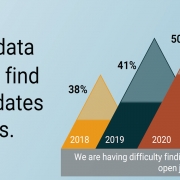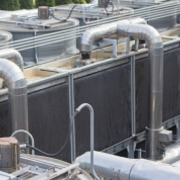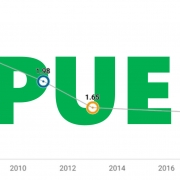Large data centers are mostly more efficient, analysis confirms
Uptime Institute calculates an industry average power usage effectiveness (PUE), which is a ratio of total site power to IT power, each year using data from the Uptime Institute Global Data Center Survey. This PUE data is pulled from a large sample over the course of 15 years and provides a reliable view of progress in facility efficiency.
Uptime’s data shows that industry PUE has remained at a high average (ranging from 1.55 to 1.59) since around 2020. Despite ongoing industry modernization, this overall PUE figure has remained almost static, in part because many older and less-efficient legacy facilities have a moderating effect on the average. In 2023, industry average PUE stood at 1.58.
For the 2023 annual survey, Uptime refined and expanded the survey questionnaire to provide deeper insights into the industry trends and improvements underlying the slow-moving average. This analysis builds on Uptime’s recent PUE research that focused on the influence of facility age and regional location (see Global PUEs — are they going anywhere?).
Influence of larger sites on PUE
Uptime’s headline PUE figure of 1.58 (weighted per respondent, for consistency with historical data) approximates the efficiency of an average facility. The new survey data allows us to analyze PUE in greater detail across a range of facility sizes. We applied provisioned IT capacity (in megawatts, MW) as a weighting factor, to examine PUE of a normalized unit of IT power. Using this approach, the capacity-weighted PUE figure is 1.47 — a result that many may expect, given the large amount of total IT power deployed in larger (often newer) data centers.
Larger facilities tend to be more efficient — most are relatively new and use leading-edge equipment, with more efficient cooling designs and optimized controls. Modernization of smaller facilities is less likely to yield a return on investment from energy savings. In Figure 1, Uptime compares survey respondents’ annual average PUE based on their data center’s provisioned IT capacity, showing a clear trend of efficiency improvements as data centers increase in capacity size.
Figure 1. Weighted average PUE by data center IT capacity

The PUE metric was introduced to track the efficiency of a given data center over time, rather than to compare between different data centers. Uptime analyzes PUE in large sample sizes to track trends in the industry, including the influence of facility size on PUE. Other factors shaping PUE include IT equipment utilization, facility design and age, system redundancy and local climate conditions.
Capacity and scrutiny will grow
Data centers are expanding in capacity — and this will warrant closer attention to the influence of facility size on efficiency. Some campuses currently have capacities of 300 MW, and several others are planned to reach in excess of 1 gigawatt (GW), which is between 10 and 30 times more power than the largest data centers seen in recent years. Uptime has identified approximately 28 hyperscale colocation campuses in development in addition to existing large hyperscale cloud sites. If the planned capacity of these sites is realized, they would account for approximately one-quarter of data center energy consumption globally.
These hyperscale colocation campuses, in common with many large new colocation facilities in existing prime data center locations, are designed for PUEs significantly below the industry average (1.4 and lower). Scala Data Centers is one example: it is building its Tamboré Campus in São Paolo (Brazil), which is intended to reach 450 MW with a PUE of 1.4. To preserve an economic advantage, the organization will need to optimize efficiency as the number of tenants filling the data halls increases.
Cloud hyperscalers Google, Amazon Web Services and Microsoft already claim PUE of 1.2 or lower at some sites. However, this is not always representative of the actual PUE of a customer application in the cloud. Their workloads may be provisioned by a colocation partner whose PUE is higher, or cloud workloads may need to be replicated across one or more availability zones — driving up energy usage and aggregating PUE across multiple facilities.
PUE improvements will be demanded as legislatures start to reference PUE in binding regulations. The new Energy Efficiency Act in Germany, which came into force in September 2023, mandates data centers in Germany to achieve a PUE of 1.5 from July 1, 2027 and a PUE of 1.3 from July 1, 2030. New data centers opening from July 1, 2026 are required to have a PUE of 1.2, or less — which even new build operators may find challenging at higher levels of resiliency.
The Uptime Intelligence View
Facility size is one of many important factors influencing facility efficiency and this is reflected in the capacity-weighted average PUE figure of 1.47, as opposed to the per-site average of 1.58. The data may suggest that over time, the replacement of older sites with larger more efficient ones may produce a more impactful or immediate improvement in efficiency than modernizing smaller sites.
Jacqueline Davis, Research Analyst, jdavis@uptimeinstitute.com
John O’Brien, Senior Research Analyst jobrien@uptimeinstitute.com





 2020
2020 Getty
Getty Uptime Institute
Uptime Institute


